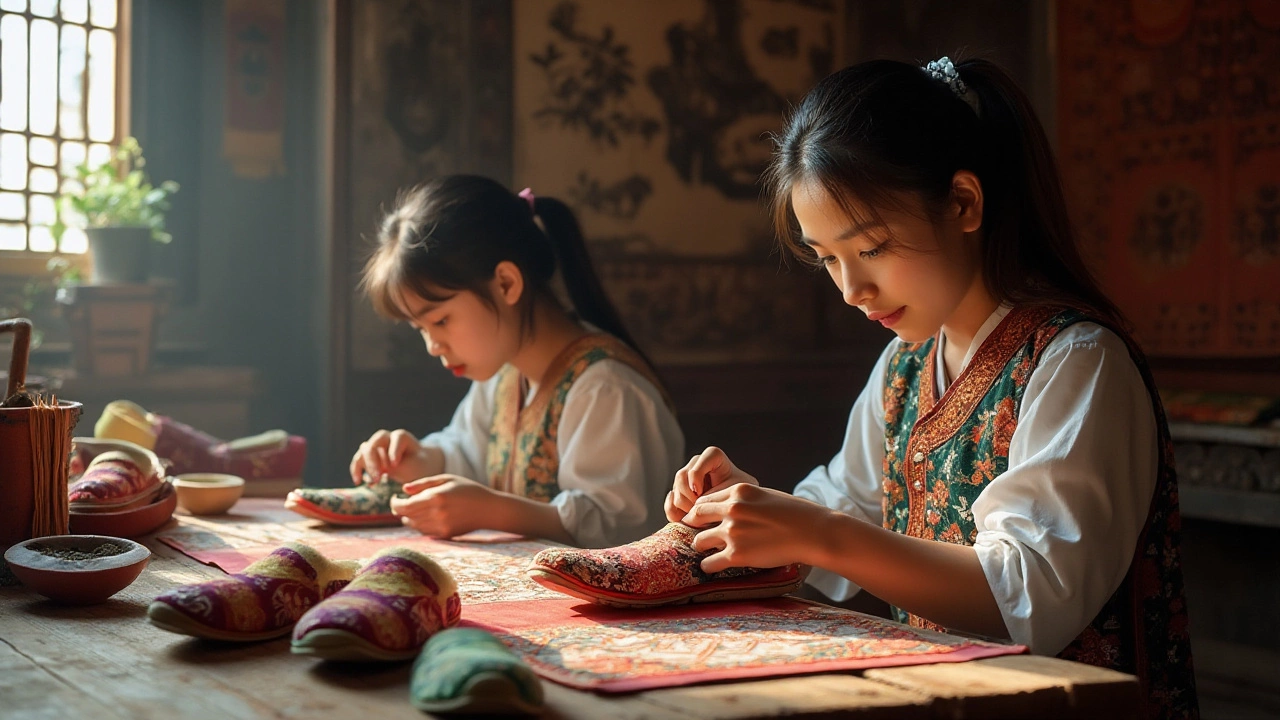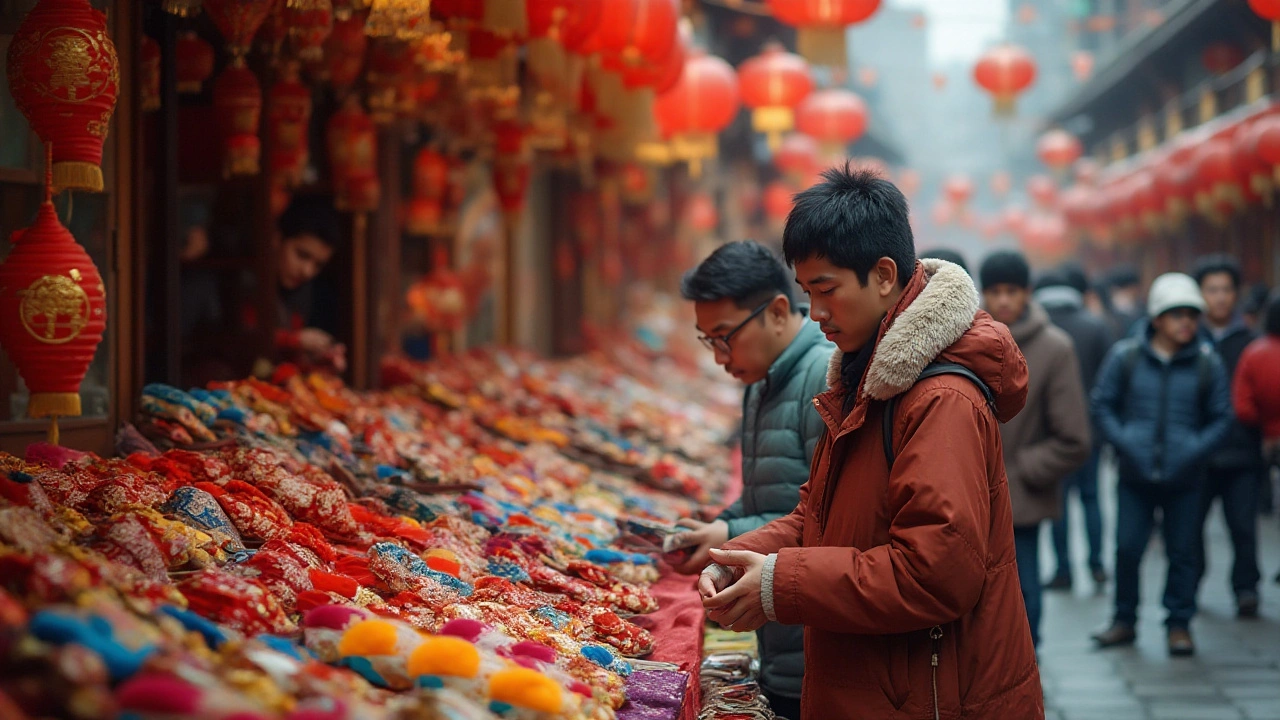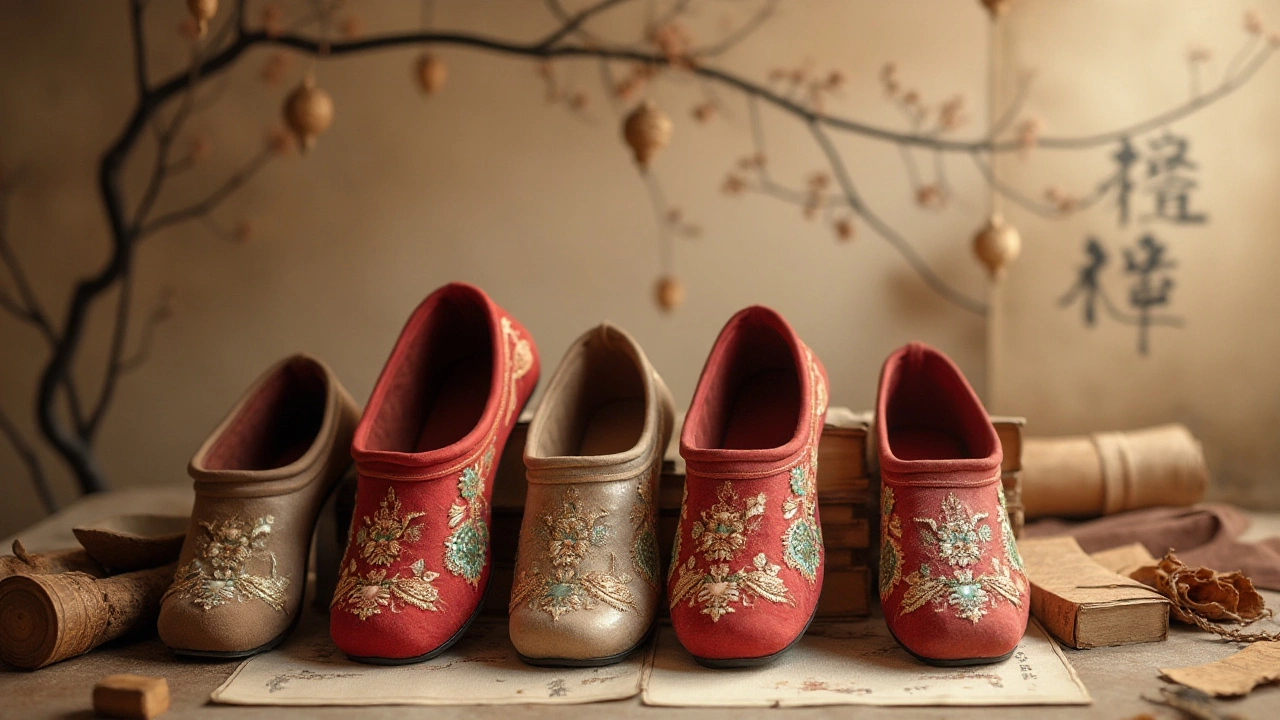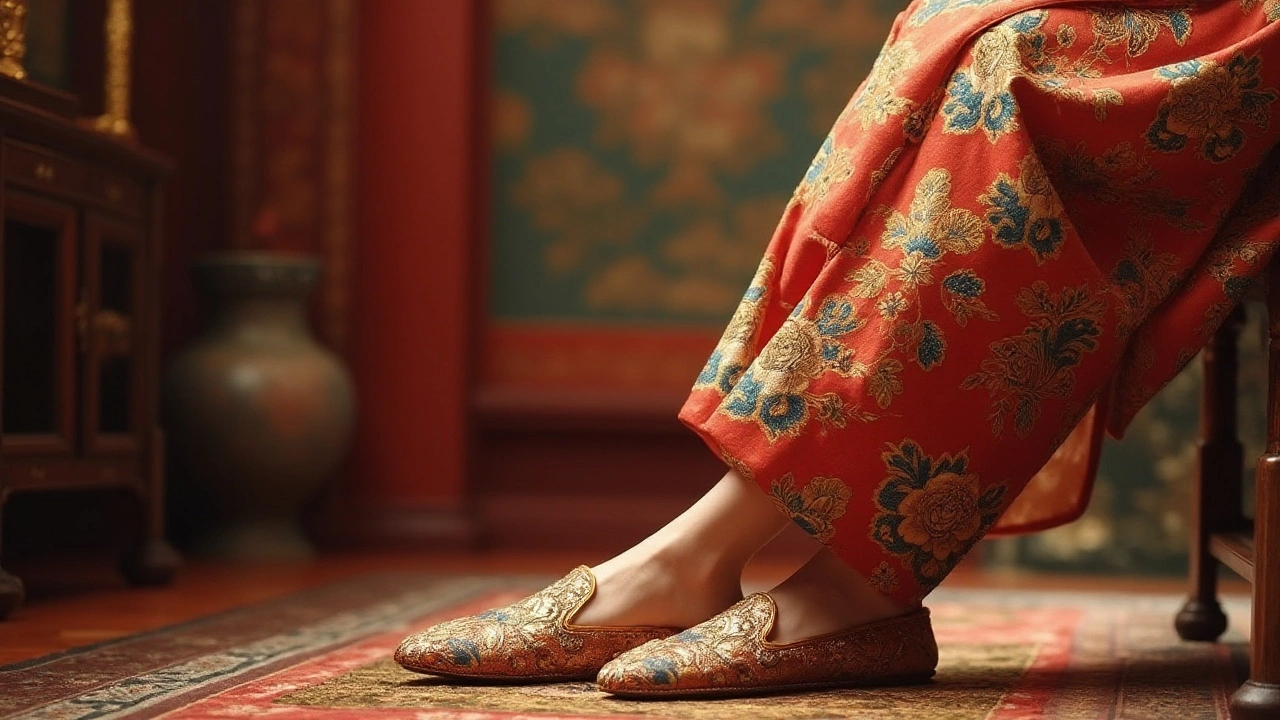Understanding the Charm of Traditional Chinese Slippers

- Cleo Fairchild
- 6 January 2025
- 0 Comments
Chinese slippers, with their intricate designs and vibrant patterns, are far more than just a piece of footwear. They represent a deep cultural heritage that dates back centuries, offering a window into the craftsmanship and artistry of ancient Chinese society. Historically worn by emperors and commoners alike, these slippers have undergone a fascinating transformation.
Their story is one of elegance, from delicate silk creations with elaborate embroidery to today's more practical cloth versions. Often paired with the traditional Hanfu clothing, Chinese slippers carried symbolic meanings, denoting status, luck, and cultural identity. As the world becomes more interconnected, these unique slippers have found a place in modern fashion, blending tradition with contemporary styles. From their role in history to their place in the present day, Chinese slippers are a testament to enduring style and cultural legacy.
Historical Origins
The journey of Chinese slippers through the annals of time is nothing short of captivating. Their origins trace back to ancient China, with evidence suggesting their existence during the Zhou Dynasty, from 1046 to 256 BC. Initially, they were humble and modest footwear predominantly worn by the common folk. However, as dynastic periods advanced, these slippers evolved into intricate symbols of status that even emperors adorned. The craftsmanship involved in creating these slippers was a revered art form. Artisans devoted extensive time and skill into intricate embroideries, often depicting Chinese myths, flora, and fauna, using silk threads and sometimes even integrating gold and silver nuances. This transformation illustrated not only the adaptation of styles but also the technological progress in textile production over centuries.
As the Han Dynasty emerged, slippers became an integral element of the fashionable attire, transcending mere necessity to become a cultural symbol. These times also saw the incorporation of felt and cloth alongside silk, introducing variations that suited both affluent and modest households. By the time of the Tang Dynasty, the slippers were embellished with patterns that indicated the wearer’s position in society and were crafted to match the ostentatiousness of the renowned Silk Road era. It's during this period that the popularity of the traditional footwear reached new magnitudes, often being cherished as valuable gifts. The Ming and Qing dynasties further emphasized the importance of historical fashion, where slippers were an integral component of ceremonial dress, carefully curated for state events and familial gatherings.
The cultural impact of these slippers was profound, demonstrating a fusion of fashion and identity. Hanfu shoes were particularly notable as they aligned with the traditional Hanfu clothing. They served as conduits for cultural preservation, demonstrating how intrinsic footwear was to societal roles and spiritual beliefs. Cultural lore from these eras further positions slippers as tokens of romantic gestures, where stories speak of lovers exchanging vibrantly embroidered slippers as symbols of affection and commitment. According to an ancient Chinese saying, “The slipper you slip on in the morning might find you good fortune during the day,” exemplifying their significance beyond functionality. This spiritual undertone etched into the fabric of everyday life showcases the depth of their historical imprint.

Cultural Significance
The cultural significance of Chinese slippers is deeply woven into the fabric of China's rich heritage and tradition. Known as an emblem of elegance and artistry, these slippers have transcended mere practicality to become a cultural artifact. Historically, they were most prevalent in the imperial courts, adored for their beauty and the intricate embroidery that often decorated them. Such embroidery could include symbols of prosperity, health, and other auspicious designs, making each pair a canvas of tradition and belief. From simple floral patterns to elaborate dragon designs, these slippers are a living testament to China’s artistic legacy.
The use of distinct styles and specific motifs often denoted the wearer's social standing or regional identity. For example, lotus designs might symbolize eternal beauty, while phoenixes and dragons were reserved for royalty as tokens of power and authority. During the Qing Dynasty, the Manchu women, known for their towering style of slipper, often made with silk and adorned with pearls, set a flashy fashion statement while protecting the inner symbolism deeply rooted in their ancestry. The craft of making such slippers was not just about fashion; it was an acknowledgment of cultural pride. A well-known Chinese proverb rightly says, "Walking a journey of a thousand miles begins beneath one's feet," signifying how every careful step carries our traditions.
Moreover, these slippers were not just for the affluent. Across various provinces, ordinary folk would prepare cloth slippers as part of dowries, with each stitch representing a wish for prosperity and happiness. They were seen as protective charms against evil spirits, a belief that resonates with ancient Chinese spirituality. During festive seasons like the Spring Festival, people would wear these traditional slippers as part of their celebration attire, connecting generationally through shared customs and shared steps taken in rhythm with their predecessors. In a piece published by the China Daily, an interview with a cultural historian revealed,
"These slippers act as silent narrators of our history, telling untold stories passed down through grandmothers and mothers, through every needle and thread,"showcasing the personal narratives woven into each pair.
As globalization introduced diverse cultures to the world, Chinese slippers stepped onto an international stage. Yet, they still maintain deep ties to their cultural roots. In modern China, cultural preservation projects and festivals often highlight these traditional footwear styles, cherishing their history while promoting craftsmanship. Whether it is understanding the symbolism, appreciating the artistry, or embracing the fashion, Chinese slippers are a bridge across time, carrying with them a universe of meaning and beauty. Thus, these humble slippers are much more than footwear; they are a celebrated part of a living cultural heritage.

Different Styles and Materials
The journey of Chinese slippers from their roots in ancient dynasties to their present forms is a tale as vibrant and intricate as the embroidery the slippers themselves often boast. These slippers, known for their delicate construction and beautiful artistry, have evolved in design and purpose over the centuries, reflecting China's rich cultural tapestry. Historically, the slippers were hand-crafted from a myriad of materials, each chosen for its significance and utility. Silk, renowned for its luxurious feel and shimmering quality, was a common choice, especially among the affluent who wore these ornate versions during special occasions and ceremonies.
For everyday wear, cotton and cloth were popular due to their durability and comfort. In regions where colder climates prevailed, wool and felt were used to provide warmth. These materials were not merely functional; they also served as canvases for elaborate embroidered patterns. Traditional motifs often found on these slippers include symbols of prosperity such as dragons and phoenixes, flowers like peonies or lotuses representing beauty and purity, or abstract patterns inspired by clouds and waves.
'Footwear was more than function; it was a canvas for weaving stories and crafting identities.' — Dr. Li Ming, historian and textile expertSuch attention to detail made these slippers an esteemed part of one's attire, essential to the visual harmony of the wearing of Hanfu, China's traditional clothing.
As times changed, so did the styles. The Qing dynasty introduced 'flower pot' shoes, known for their characteristic elevated sole, designed to accentuate the stature and grace of women. In contemporary times, while traditional Chinese slippers remain popular for cultural festivals and even as exquisite gifts, their design has embraced modern materials like synthetic fabrics and rubber soles to cater to today's fast-paced lifestyle. This blend of the traditional with the contemporary ensures that these slippers remain relevant in the modern wardrobe, combining comfort with cultural pride. Fashion designers continue to draw inspiration from these historical pieces, often incorporating traditional elements into haute couture collections, demonstrating that the allure of Chinese slippers is timeless.

Modern Usage and Popularity
Today, Chinese slippers have found a new life in the fast-paced world of fashion. Their delicate embroidery and vibrant colors continue to capture the imagination of designers and fashion enthusiasts alike. These timeless accessories are seen gracing the feet of both the young and the old, showcasing a blend of traditional grace and modern flair. In a world where fashion trends tend to come and go like waves on the ocean, Chinese slippers have managed to hold their ground, steadfast in their appeal. The versatility of these slippers is perhaps one of their strongest suits, as they complement not only traditional attire but also contemporary fashion ensembles. By infusing a touch of history into modern wardrobe choices, they offer both comfort and a conversation starter.
The rise of cultural appreciation and the urge to explore heritage has prompted a newfound interest in ethnic wear. Whether paired with jeans for a casual outing or highlighted in a more formal setup, these slippers are earning their place as a symbol of elegance that transcends time. With social media platforms buzzing with influencers sporting these beautiful slippers, it's clear that their popularity is on the upswing. They've become much more than just footwear; they’ve become an expression of individuality and an ode to craftsmanship. Many digital platforms and e-commerce sites have noted a surge in searches and purchases of Chinese slippers, indicating a robust interest in this traditional attire around the globe.
The spotlight on sustainability in fashion has also added to the allure of Chinese slippers. Often crafted from fabric and materials that are environmentally friendly, they offer a compelling alternative for the eco-conscious consumers of today. This trend sits well with broader global shifts towards sustainable fashion practices. Blockbusters and TV series set in historical or fantastical landscapes frequently showcase exquisite Chinese slippers, sparking curiosity and desire among audiences. People no longer merely view them as relics of the past but as vibrant accessories that are relevant today. Designers are continually finding new ways to reinterpret traditional designs, making them more accessible and desirable for contemporary users.
Interestingly, there is a resurgence in traditional events and festivals where these slippers take center stage. They are prominently featured in weddings, cultural gatherings, and traditional dance performances, enhancing their symbolic status. Collaborations with renowned designers have also brought Chinese slippers into high fashion circles, where they are celebrated as exotic pieces of art. One could observe their influence extending beyond fashion to home decor, with aesthetic nuances borrowed from slipper designs inspiring items like cushions and wall art. The role of Chinese slippers in ceremonial contexts remains strong, further cementing their status as an enduring emblem of Chinese culture.
Alice Wang, a curator at the Museum of Chinese in America, once noted, "Chinese slippers are more than just an accessory; they are a bridge connecting us to our ancestry and history." As we delve into the nuances of how these slippers have maintained their charm, it's evident that they hold a special place in the tapestry of world fashion, embracing an ethos that is both unique and inclusive.


